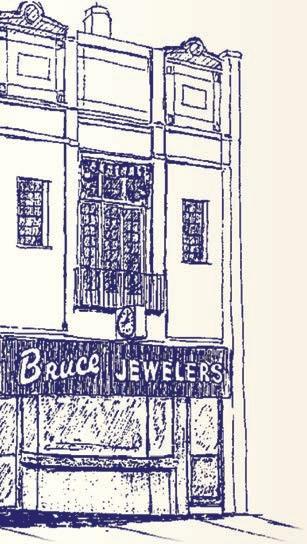
9 minute read
May’s Flying Service
A soar back to May’s Flying Service
T“There are old pilots and there are bold pilots, but there are no old, bold pilots!”
This bit of wisdom has been axiomatic among aviators since Orville Wright wobbled into the air over Kitty Hawk in 1903.
Melvin May, a Princeton native, was always interested in flying, and in 1939, he and a group of 12 young men formed a flying club and purchased a new Piper Cub J3 trainer, powered with a 50 h.p. Franklin engine.
The 12 men were Hi Piper,
Tommy Ioder, Otto Bouxsein,
Melvin May, Walter May,
Randy Peterson, Dr. Hartley,
Leo Lenihan, Len Swanson,
W. Wedding, Joe Moran and
Marvin May.
The J3 Piper Cub had no brakes or tail wheel. Melvin took instructions from a flight instructor in the plane from
LaSalle and soloed on his 31st birthday July 14, 1939.
The first airport hangar was built out of old barn wood and erected just north of City
County Park, north of Princeton. They had talked a local farmer into letting them have an unused field for a landing
By Bill Lamb

strip. This wasn’t a particularly generous gesture by the farmer, for the field was so small that sparrows had to slip into it to avoid over-shooting the field.
The young pilots of the flapless, brakeless, Cub plane had an even tougher time in landing and taking off.
But with the confidence of youth, a little skill and a great deal of luck, they learned to fly without killing themselves or even scratching their airplane.
In time, most of the original 12 men began to drift away from flying, but the aviation bug had bitten Melvin more deeply and he was a seasoned pilot when America plunged into war in December 1941.
Melvin immediately signed-up for the Civilian Pilot Training Program and was sent to Ft. Sill, Okla., to join the staff assigned to teach the third group of student aviators turned out by the Army Ground Forces in World War II.
In 1942, he took a refresher course at Ft. Sill and started instructing Aug. 28, 1941. He was commissioned Second Lt. in March 1943 and rated a liaison pilot at Waco, Tx.
In 1943, Melvin then accepted a direct commission in the field artillery and remained at Ft. Sill as a flight instructor until the war ended in 1945. Flying time was built-up slowly, and by 1942, he had logged a total of 250 hours with no mishaps. May signed-up for a commercial pilot’s course under the Civil Pilot Training Program at Springfield Aviation Company and received his commercial pilot’s license in July 1942.
During his tour at Ft. Sill, he attended a Piper Airport basic instrument and night flying course at Goodfellow Field in San Angelo, Tx. Melvin was instructor at the army sea plane base on Lake Lawtonka and was checked-out on the Brodie Landing System.
Upon leaving the service in July 1945, Melvin decided to start a flying school in Princ

See May’s page 8
May’s
FROM PAGE 7 eton. He rented the Piper Airport from which he operated as May’s Flying Service. He was joined in 1946 by his brother, Marvin, who was an A. and E. mechanic. They operated this business service jointly until January 1951, when Melvin returned to Ft. Sill as a civilian flight instructor. Several Bureau County members of the Army Air Corps already had publicly expressed the wish that an airport be constructed in the county. One or two civic groups in Princeton appointed airport committees to investigate the possibilities of building
Marvin and Walter May an airfield in this area. with Cessna 172. R.J. Piper didn’t wait for the committee to get underway, however, but quietly went ahead with his own construction plans. The field was laid May’s Flying Service, out a mile east of Princeton. The hanger was built, and it was not long after that the field became “official” with introduction of qualified instruction.
The airport was destine to become the local aviation center for flying enthusiasts. More enthusiastic than ever about the future of aviation and the desire of civilians to learn to fly, Melvin was anxious to organize a flight training program in his home community of Princeton.
He completed arrangements with Mr. Piper to start public instruction at the Piper Airport.
Melvin negotiated for the purchase of his first Piper Cub plane to be used in training and additional cubs were bought as the need arose for them.
In the fall of 1945, organized instruction courses began at Piper Airport, where the public was welcome to learn to fly light aircraft.
It wasn’t long that the aviation boom was in full swing. The hangar was expanded to take care of additional planes.
Piper Airport had one trainer and one coupe available by train ing purposes, in addition to a Hangar with planes and motorcycles. May’s Cycle Shop began in 1946. Waco cabin plane owned by R.J. Piper, which was for passenger flights. Lt. Earl Wolf Jr. was at the airport on Sundays to fly passengers in the Piper plane.
Melvin held lessons daily, from dawn to dusk, with his busiest days being Sundays and Thursdays. The early evening hours also were crammed with appointments by local businessmen, who were anxious to close-up their stores at the end of the day and drive to the airport for lessons.
Some were receiving their instruction a half-hour at a time and others were in the air a full hour daily. Most of the students were ready after seven or eight hours. Ten hours in the air with the instructor and 30 added hours of solo flight were required to earn a private pilots license.
Then in January 1951, Melvin returned to Ft. Sill as a civilian flight instructor on fixed wing aircraft. Marvin May took over, having received his instructor’s rating shortly after he returned from the service and joined

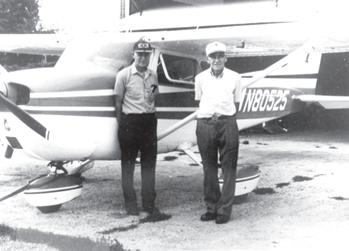
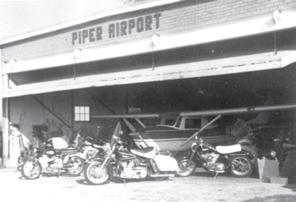
Melvin in 1946.
Elmo Salsman joined the Mays and was chief instructor in 1951. When Melvin left, Elmo was their instructor.
There was never any major mishap in the air around Princeton, but there were several emergencies with some minor damage to the aircraft, but they usually landed without any trouble. They weren’t charged against Melvin May with Stearman biplane at Goodfellow Field their record as an accident San Angelos, Tex., U.S. unless it cost a considerArmy Air Corps. able amount of money to repair it.
From Ft. Sill, Okla., May moved to Ft. Rucker in 1954, where he remained the rest of his military career. He retired in 1971.
After a year of teaching cross country navigation in L-19s and L-20s, he became intrigued with the new fangled helicopters, and at the post-adolescent age of 47, he learned to fly them. His job was to teach new instructor pilots and to fly periodic check rides with the assigned instructors.
Melvin was ideally fitted for this role. He was respected by students and the oldest pros alike for his all-around professionalism and his never-failing ability to spot and correct pilot faults.
Happily for Ft. Rucker, Melvin remained there many years. Therefore, you could expect to see this sprightly old gentleman, who looked so much like your favorite grandfather, climbing into a chopper everyday and completely wearing out a young aviator who was no more than a third his age.
During his 18-and-a-half years in the training establishment, Melvin gave over 2,500 check rides and graduated over 450 students.
Melvin was chosen by his superiors on several occasions to give rotary wing trainings to VIPs not only from the U.S. Army, but from several allied countries. His personality and flying ability allowed him to successfully complete these check-outs and he was often requested by VIPs for more advanced work in different aircraft.
The significance of his outstanding flying record can be appreciated only when it is understood that these 11,000 flight hours were spent in contact instruction involving numerous landings and take-offs per-hour. This type of flying had an extremely high accident exposure rate and Melvin had met this situation with this truly outstanding record.
Up to the time he retired in 1971, Melvin was the only instructor at the U.S. Army Aviation School to obtain over 11,000 accident-free flying hours. Such an achievement was without parallel in this field and because of the outstanding accomplishment, Melvin deserved and receive appropriate recognition and reward.
It is hard to give a monetary value to his flying record, but with the accident rate up to that time then of 20 accidents per 100,000 flying hours and an average cost-per-accident of $40,000, Melvin had saved the government approximately $100,000.
The May Flying Service and the hangar and the offices was where the thrills and excitement was for many years for the air-minded enthusiasts and we had quite a few.
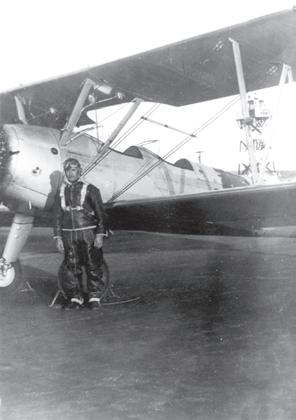
OUT OF THE PAST: This “Out of the Past” article by Bill Lamb, with accompanying photos, is provided courtesy of the Bureau County Historical Society, Princeton.

• NEW HOMES • GARAGES • ROOFING • SIDING • ROOM ADDITIONS • POLE BUILDINGS • REMODELING
Post Office Box 114 Walnut, IL. 61376 Email: haroldrollo@yahoo.com Website: www.rolloconstruction.com
•FREE ESTIMATES• Home: 815-379-9317 Ans. Machine: 815-379-2350
Cell Phone: 815-303-9321

BRING HAPPINESS HOME
SILK & FRESH FLOWERS | SEASONAL DISPLAYS WEDDINGS | HOME DECOR

815-875-3819 811 E. Peru St. Princeton, IL 61356 | M-F 8:30-5:30 SAT 8:30-5 flowersbyjuliaprinceton.com | fbjulia@ivnet.com
M.R. Holmbeck, D.V.M. B.R. Sondgeroth, D.V.M. C.M. Schelkopf, D.V.M. A.M. Adams, D.V.M. K.A. Reed, D.V.M.
BUREAU VALLEY

VETERINARY SERVICE LTD.
820 Backbone Rd East • Princeton, IL 61356 (815) 875-1621 (815) 875-5041 fx
Lorita Hellman, Agent 324 N Main St Princeton, IL 61356 Bus: 815-875-2393 www.lhellman.com
Combine Home & Auto. Save big.
Good things happen when you combine your home and auto insurance with State Farm ® . Plus, you’ll have a good neighbor like me to help life go right. CALL ME TODAY.
Bureau County Senior Center
815-879-3981 • (toll free) 800-554-5955 16 West Marion Street, Princeton, Illinois 61356
SM-PR1783862
www.bcseniorcenter.com
FARRELL CHIROPRACTIC CLINIC
Pictured from left: Dr. Lori Schultz, Dr. Dennis Farrell, Dr. Jarred Farrell
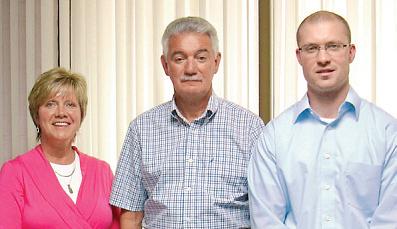
JEWELERS
Diamonds Fine Jewelry Watches Custom Designs Clocks Remounts
